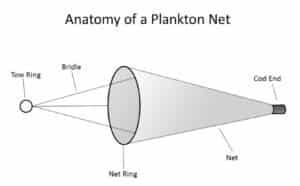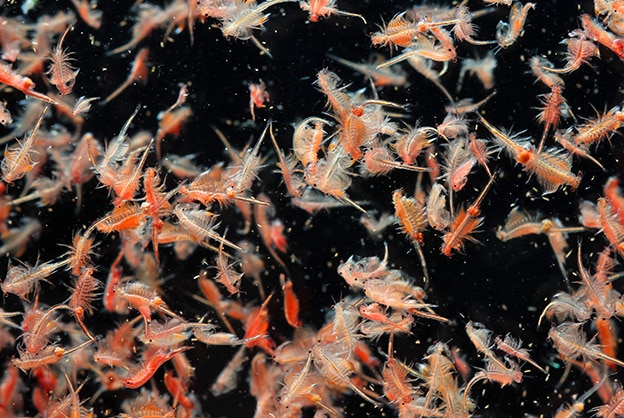Overview
STEM careers
Time
Materials
Per Whole Group:
|
Per Team:
|
Relevant Terminology
Phytoplankton: Microscopic plants that live suspended in the water. Phytoplankton are the foundation of the ocean food web and produce about 50% of Earth’s oxygen.
Zooplankton: Microscopic animals that live suspended in the water. Zooplankton may live their whole lives drifting in the current, or they may be larval forms of larger organisms.
Introduce
GETTING READY
Fill the aquarium, trough, or pool with water and add a little bit of glitter, which will represent the plankton. Fill the wash bottles with water.
INTRODUCTION
Introduce the activity by describing plankton and their role in ecosystems: Plankton refers to animals and plants that drift along in water currents. Most are microscopic. Although small in size, they form the basis of the aquatic food web. Many animals, including whales, depend on them.
- Ask questions to activate participants’ knowledge of plankton and aquatic life.
- What are three things you know about plankton? (microscopic, plant/animal plankton, basis of the aquatic food web)
- What are some animals that feed on plankton? How do they catch their food? (sponges, corals, clams, whale sharks, filter feeders)
- If plankton are microscopic, how can we collect them for study?
Instructions
Introduce the design challenge. Participants will work in teams to design and build plankton nets that they will test by filtering glitter out of water. Provide the following constraints:
- Each plankton net should concentrate the glitter into a small container.
- The plankton net should be easy to move through the water.
- The plankton net should be reusable.
Design and construct the net:

Figure 1 – Anatomy of a Plankton Net. Credit: Carnegie Science Center.
Divide participants into small teams. Show them Figure 1, Anatomy of a Plankton Net so that they can visualize what they are about to construct. Creating the plankton net will take approximately one hour. Provide the following instructions to teams as they complete each step:
- Make the net ring out of the wire clothes hanger. Cut off the twisted ends and the hook with wire cutters. Each team should think about how large the net ring will be and how they will construct it out of the materials provided. Caution: Cut ends of wire hangers may be sharp. Use needle- nose pliers to shape the wire, if necessary.
Tip: Plankton nets are wider at the net ring than at the cod end. This allows the plankton to be concentrated in the collection bottle. - Choose a material for the net (if using pantyhose, cut one leg off from the pair and use it like a stocking). Find a way to secure the fabric to the net ring. Be sure to leave an opening at the other end for the next step.
- Secure a bottle to the end of the net (open end of the bottle facing the net ring).
- Cut three strings of equal length to attach to the net ring. Use some of the hanger wire to fashion a tow ring, and tie the strings to the tow ring as in Figure 1. Note that participants will need to save some string to tow their plankton net through the water.
Test and redesign:
Explain to participants that they need to test their net to make sure it will work as intended in the field. To test, each team does the following:
- Tow the plankton net through the aquarium, trough, or pool for 30 seconds.
- Remove the plankton net from the water by lifting the net ring. Allow water to drain from the net, concentrating the glitter in the cod end.
- Use a wash bottle with water to wash any glitter stuck on the net into the cod end.
- Make any necessary modifications to the plankton net and test again.
As needed, give teams the following hints to use during redesign:
- If the plankton tow is difficult to pull through the water, the material chosen may be too dense or have too much resistance. Choose a material that allows more water through.
- If the plankton isn’t concentrating adequately, make sure the shape of the net directs the plankton into a smaller area.
Evaluate the success of each design.
- Did the plankton net concentrate glitter into the collection bottle?
- Did the plankton net stand up to being towed through the water?
- Could your design be reused?
ACTIVITY VARIATIONS
If you have access to a body of water, use the nets to collect live plankton to observe under a microscope.
Test different sizes of net ring and cod end. Use thick wire that can be cut to length for the ring and a variety of different bottles for the cod end.
Design a variety of instruments to sample the small animals that live among the stones in the bottom of creeks or ponds (benthic macroinvertebrates) instead of plankton. Pair this activity with a lesson on food webs.
Guiding questions
GUIDANCE FOR YOUNGER CHILDREN
QUESTIONS TO ASK AFTER THE ACTIVITY
- How effective was your net at collecting the glitter?
- What could you change to improve its performance?
- Would your plankton net work in a real-life setting? Why or why not?
GUIDANCE FOR OLDER YOUTH AND ADULTS
QUESTIONS TO ASK AFTER THE ACTIVITY
- How effective was your net at collecting the glitter?
- Besides glitter, what other substances could you collect to test your net, to replicate the catching of plankton?
- Would your plankton net work in a real-life setting? Why or why not?
- What could you change to improve your net’s performance?
- How would elongating the net affect its function? What about shortening it?
Engineering & science connections
GUIDANCE FOR YOUNGER CHILDREN
Engineering Connections
Collecting plankton samples on research vessels is important for understanding our oceans, but it is expensive. Inviting informed citizens to collect samples helps with the cost. Engineers and biologists with the Water-worked Environments Research Group at the University of Auckland, in New Zealand, are working together to find new ways for citizen scientists to collect and analyze plankton samples. One of their major challenges is to design a low-cost, yet effective, plankton net for use on sailing yachts. These engineers need to understand not only what forces and flows act on a plankton net, but also how to collect the plankton without damaging these delicate organisms.
Science Connections
Plankton are the basis of the ocean food web. Phytoplankton are microscopic algae that produce half of all the oxygen in our atmosphere; zooplankton are tiny animals that eat the phytoplankton and are then eaten by larger animals. Without these tiny organisms, many species of fish, corals, sponges, and whales would not be able to survive. By studying plankton, we can monitor the health of the oceans in the face of pollution and climate change.
GUIDANCE FOR OLDER YOUTH AND ADULTS
Engineering Connections
Collecting plankton samples on research vessels is important for understanding our oceans, but it is expensive. Engineers and biologists with the Water-worked Environments Research Group at the University of Auckland, in New Zealand, are working together to find new ways for citizen scientists to collect and analyze plankton samples as one way to allay costs. One of their major challenges is to design a low-cost, yet effective, plankton net for use on sailing yachts. These engineers need to understand not only what forces and flows act on a plankton net, but also how to collect the plankton without damaging these delicate organisms.
Engineers also work on ways to capture the organisms that live on the bottom of bodies of water. One method used is a benthic sled, which slides over the surface, kicking up the sediment and microorganisms so that they can be captured in a net. You can see a benthic sled in action at youtube.com/watch?v=yVXPZQWeMgQ
Science Connections
By studying plankton, we can monitor the health of bodies of water in the face of pollution and climate change. Certain species are more sensitive than others to pollution, lack of oxygen, or other environmental factors. Monitoring changes in plankton populations may allow scientists to pinpoint pollution sources.
The source for this activity was developed by the Fleet Science Center, in association with MacGillivray Freeman Films and Pacific Life.
All rights reserved.
Supplemental content adapted for Dream Big Activities by Carnegie Science Center.


0 Comments